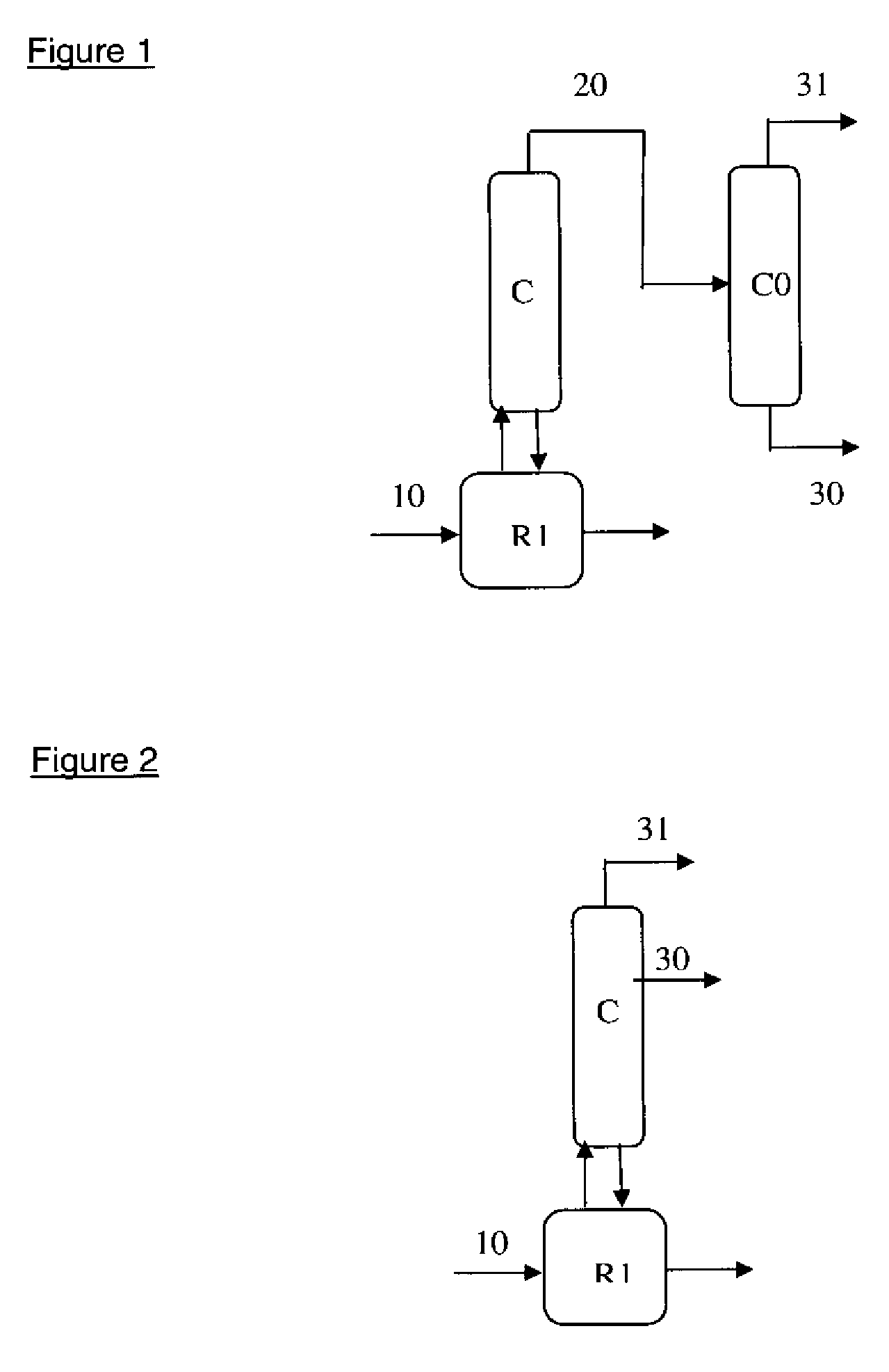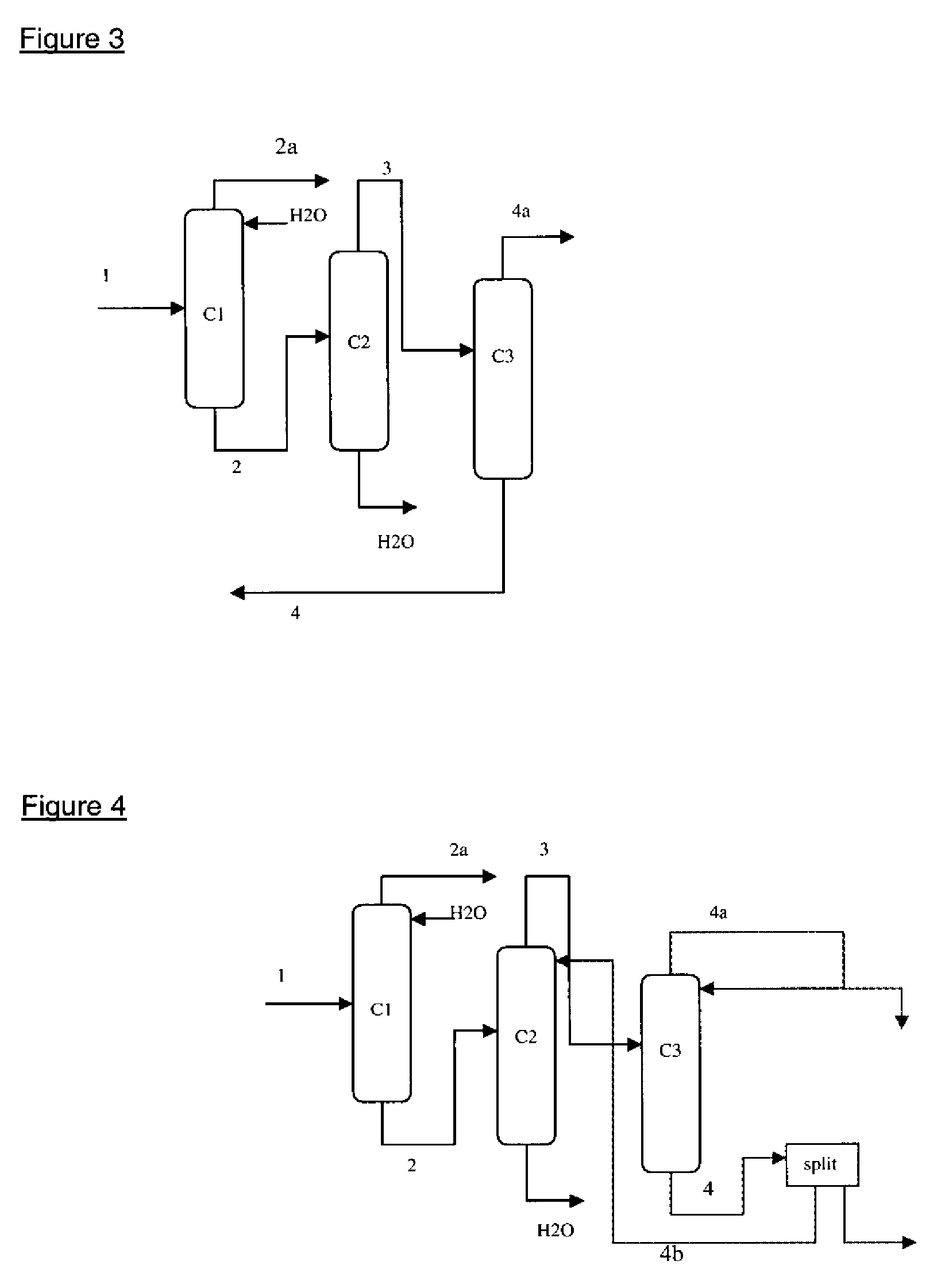Method for purifying the azeotropic fraction generated during the synthesis of N,N-dimethyl aminoethyl acrylate
a technology of azeotropic fraction and synthesis method, which is applied in the direction of carboxylic acid amide preparation, organic chemistry, and separation/purification of carboxylic acid esters, etc., can solve the problems of contamination, production of methyl acrylate or ethyl acrylate, and difficulty in purification of the lower acryla
- Summary
- Abstract
- Description
- Claims
- Application Information
AI Technical Summary
Benefits of technology
Problems solved by technology
Method used
Image
Examples
examples
[0066]The percentages are expressed as percentages by weight.
[0067]The following abbreviations are used:[0068]EA: ethyl acrylate[0069]MA: methyl acrylate[0070]HQME: hydroquinone methyl ester
examples 1 to 4
[0071]A double-jacketed reactor supplied with oil at 80° C. and surmounted by a distillation column with Multiknit packing (efficiency: 15 theoretical plates), with a condenser at the top of the column supplied with oil at 50° C. and a dry-ice trap, is charged with:[0072]500 g or 550 g of fraction to be treated (containing 40% of EA; 59.5% of ethanol; acetaldehyde; diethoxyethane)[0073]0 or 50 g of Lewatit K1461 or Amberlyst 15 resin[0074]0 or 50 g of water[0075]0.1% HQME
the total weight of the fraction to be treated+water being equal to 550 g.
[0076]Bubbling with low-oxygen air at 8% O2 (vol.) is maintained throughout the test (3 hours).
[0077]It is heated to boiling at 63° C., removing the acetaldehyde by distillation as it forms.
[0078]The contents of acetaldehyde and of diethoxyethane are determined by gas chromatography.
[0079]
AcetaldehydeDiethoxyethaneFraction to beWeight aftercontent, ppmcontent, ppmType of resinWater, gtreated, gtreatment, ginitialfinalinitialfinalEx 1None505004...
example 5
[0081]The preceding mixture from example 2 (500 g of fraction to be treated and 50 g of water) is treated in a stirred reactor heated by a double jacket provided with recirculation on a cartridge containing 200 ml of LEWATIT K1461 resin. The reactor is surmounted by a column with Multiknit packing of efficiency equal to 20 theoretical plates equipped with a condenser supplied with water at 30° C.
[0082]The mixture is fed into the reactor at a flow rate of 1500 g / h.
[0083]The acetaldehyde is distilled at the top of column at about 30 g / h. The composition of the overhead product is as follows:[0084]EA: 28%[0085]Ethanol: 66%[0086]Acetaldehyde: 0.06%
[0087]The final mixture contains:[0088]EA: 40%[0089]Ethanol: 59.5%[0090]Diethoxyethane: 180 ppm
[0091]The degree of removal of potential diethoxyethane in the mixture before treatment is greater than 90%.
PUM
| Property | Measurement | Unit |
|---|---|---|
| Mass | aaaaa | aaaaa |
| Fraction | aaaaa | aaaaa |
| Concentration | aaaaa | aaaaa |
Abstract
Description
Claims
Application Information
 Login to View More
Login to View More - R&D
- Intellectual Property
- Life Sciences
- Materials
- Tech Scout
- Unparalleled Data Quality
- Higher Quality Content
- 60% Fewer Hallucinations
Browse by: Latest US Patents, China's latest patents, Technical Efficacy Thesaurus, Application Domain, Technology Topic, Popular Technical Reports.
© 2025 PatSnap. All rights reserved.Legal|Privacy policy|Modern Slavery Act Transparency Statement|Sitemap|About US| Contact US: help@patsnap.com



